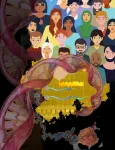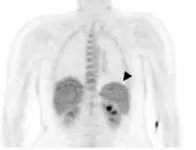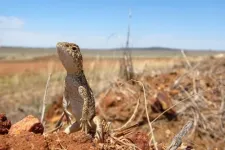(Press-News.org) Quantum computing and quantum sensing have the potential to be vastly more powerful than their classical counterparts. Not only could a fully realized quantum computer take just seconds to solve equations that would take a classical computer thousands of years, but it could have incalculable impacts on areas ranging from biomedical imaging to autonomous driving.
However, the technology isn't quite there yet.
In fact, despite widespread theories about the far-reaching impact of quantum technologies, very few researchers have been able to demonstrate, using the technology available now, that quantum methods have an advantage over their classical counterparts.
In a paper published on June 1 in the journal Physical Review X, University of Arizona researchers experimentally show that quantum has an advantage over classical computing systems.
"Demonstrating a quantum advantage is a long-sought-after goal in the community, and very few experiments have been able to show it," said paper co-author Zheshen Zhang, assistant professor of materials science and engineering, principal investigator of the UArizona Quantum Information and Materials Group and one of the paper's authors. "We are seeking to demonstrate how we can leverage the quantum technology that already exists to benefit real-world applications."
How (and When) Quantum Works
Quantum computing and other quantum processes rely on tiny, powerful units of information called qubits. The classical computers we use today work with units of information called bits, which exist as either 0s or 1s, but qubits are capable of existing in both states at the same time. This duality makes them both powerful and fragile. The delicate qubits are prone to collapse without warning, making a process called error correction - which addresses such problems as they happen - very important.
The quantum field is now in an era that John Preskill, a renowned physicist from the California Institute of Technology, termed "noisy intermediate scale quantum," or NISQ. In the NISQ era, quantum computers can perform tasks that only require about 50 to a few hundred qubits, though with a significant amount of noise, or interference. Any more than that and the noisiness overpowers the usefulness, causing everything to collapse. It is widely believed that 10,000 to several million qubits would be needed to carry out practically useful quantum applications.
Imagine inventing a system that guarantees every meal you cook will turn out perfectly, and then giving that system to a group of children who don't have the right ingredients. It will be great in a few years, once the kids become adults and can buy what they need. But until then, the usefulness of the system is limited. Similarly, until researchers advance the field of error correction, which can reduce noise levels, quantum computations are limited to a small scale.
Entanglement Advantages
The experiment described in the paper used a mix of both classical and quantum techniques. Specifically, it used three sensors to classify the average amplitude and angle of radio frequency signals.
The sensors were equipped with another quantum resource called entanglement, which allows them to share information with one another and provides two major benefits: First, it improves the sensitivity of the sensors and reduces errors. Second, because they are entangled, the sensors evaluate global properties rather than gathering data about specific parts of a system. This is useful for applications that only need a binary answer; for example, in medical imaging, researchers don't need to know about every single cell in a tissue sample that isn't cancerous - just whether there's one cell that is cancerous. The same concept applies to detecting hazardous chemicals in drinking water.
The experiment demonstrated that equipping the sensors with quantum entanglement gave them an advantage over classical sensors, reducing the likelihood of errors by a small but critical margin.
"This idea of using entanglement to improve sensors is not limited to a specific type of sensor, so it could be used for a range of different applications, as long as you have the equipment to entangle the sensors," said study co-author Quntao Zhuang, assistant professor of electrical and computer engineering and principal investigator of the Quantum Information Theory Group"In theory, you could consider applications like lidar (Light Detection and Ranging) for self-driving cars, for example."
Zhuang and Zhang developed the theory behind the experiment and described it in a 2019 Physical Review X paper. They co-authored the new paper with lead author Yi Xia, a doctoral student in the James C. Wyant College of Optical Sciences, and Wei Li, a postdoctoral researcher in materials science and engineering.
Qubit Classifiers
There are existing applications that use a mix of quantum and classical processing in the NISQ era, but they rely on preexisting classical datasets that must be converted and classified in the quantum realm. Imagine taking a series of photos of cats and dogs, then uploading the photos into a system that uses quantum methods to label the photos as either "cat" or "dog."
The team is tackling the labeling process from a different angle, by using quantum sensors to gather their own data in the first place. It's more like using a specialized quantum camera that labels the photos as either "dog" or "cat" as the photos are taken.
"A lot of algorithms consider data stored on a computer disk, and then convert that into a quantum system, which takes time and effort," Zhuang said. "Our system works on a different problem by evaluating physical processes that are happening in real time."
The team is excited for future applications of their work at the intersection of quantum sensing and quantum computing. They even envision one day integrating their entire experimental setup onto a chip that could be dipped into a biomaterial or water sample to identify disease or harmful chemicals.
"We think it's a new paradigm for both quantum computing, quantum machine learning and quantum sensors, because it really creates a bridge to interconnect all these different domains," Zhang said.
INFORMATION:
Irvine, CA - June 1, 2021 - A new study analyzing the association between an individual's genetics (genotype) and their observable characteristics resulting from the interaction of genetics and the environment (phenotype), contributes new knowledge to the understanding of human complex traits and diseases.
The study titled, "An atlas of alternative polyadenylation quantitative trait loci (3?aQTLs) contributing to complex trait and disease heritability," was recently published in Nature Genetics. Led by University of California, Irvine professor of ...
Over 50% of adults surveyed across six different countries report experiencing weight stigma, and those who engage in self-stigma and self-blame for their weight are more likely to avoid healthcare, obtain less frequent checkups, and perceive less respect from doctors, according to two new studies from the UConn Rudd Center for Food Policy and Obesity. These studies, which compared experiences of adults in Australia, Canada, France, Germany, the UK, and the US are the first multi-national studies to examine the link between weight stigma and negative ...
Plasmodium vivax malaria is a mosquito-borne illness that causes significant morbidity. However, the household and healthcare provider costs of the disease are unknown. A new study published in the open-access journal PLOS Medicine by Dr Angela Devine at Menzies School of Health Research in Australia, and colleagues estimate the global economic burden of P. vivax for the first time using country-level data.
Researchers first estimated household and healthcare provider P. vivax costs, then collated and combined these data with national case estimates for 44 endemic countries in 2017. The resulting global cost estimate was US$359 million.
The authors wanted to explore how these cost estimates might change with widespread access to radical cure. Radical ...
Observational studies have suggested that increased vitamin D levels may protect against COVID-19. However, these studies were inconclusive and possibly subject to confounding. A study published in PLOS Medicine by Guillaume Butler-Laporte and Tomoko Nakanishi at McGill University in Quebec, Canada, and colleagues suggests that genetic evidence does not support vitamin D as a protective measure against COVID-19.
The ability of vitamin D to protect against severe COVID-19 illness is of great interest to public health experts, but has limited supporting evidence. To assess the relationship between vitamin D levels and COVID-19 susceptibility ...
A nationwide study in Sweden estimates the elevated risk of advanced or fatal prostate cancer among relatives of men with the disease, providing new data that could help refine guidelines for the age at which screening should begin. Mahdi Fallah and Elham Kharazmi of the German Cancer Research Center (DKFZ) in Heidelberg, Germany, and colleagues present these new findings in the open-access journal PLOS Medicine.
Clinical guidelines for the age to start prostate cancer screening aim to ensure that the benefits of identifying the disease early ...
The malaria parasite Plasmodium vivax may accumulate in the spleen soon after infection to a greater extent than its better-known relative P. falciparum, according to new research published by John Woodford of the University of Queensland, Brisbane, Australia and colleagues in the open access journal PLOS Medicine.
Managing and treating P. vivax and P. falciparum infections calls for investigation of their different pathways of infection, and our limited understanding of disease pathology has generally relied on indirect and imprecise approaches. Woodford and colleagues studied 7 healthy participants who were infected under controlled conditions with either P. vivax or P. falciparum. They underwent a Positron Emission Tomography (PET) ...
Many organisms in need of conservation are still unknown or lumped in with similar species, which potentially interferes with conservation efforts. In a new study published June 1 in the Open Access journal PLOS Biology, Jane Melville of Museums Victoria, and her colleagues present a new "return-on-investment" approach to best direct efforts to identify new species before they are lost.
Humans have had a profoundly destructive impact on global biodiversity. However, this loss of biodiversity may be even greater than scientists have realized, due to the unknown number of undocumented species. Before a species and its habitat can be preserved, though, it must first ...
Stigma and high care needs can present barriers to the provision of high-quality primary care for people with opioid use disorder (OUD) and those prescribed opioids for chronic pain. A study published in PLOS Medicine by Tara Gomes at the Li Ka Shing Knowledge Institute of St. Michael's Hospital, Toronto, Canada and colleagues suggests that people treated for an opioid use disorder were less likely to find a new primary care provider (PCP) within one year of termination of enrolment with the previous physician.
People with substance use disorders often have complex medical needs, requiring ...
A new analysis of adults aged 80 years and older shows that a healthier lifestyle is associated with a lower risk of cognitive impairment, and that this link does not depend on whether a person carries a particular form of the gene APOE. Xurui Jin of Duke Kunshan University in Jiangsu, China, and colleagues present these findings in the open-access journal PLOS Medicine.
The APOE gene comes in several different forms, and people with a form known as APOE ε4 have an increased risk of cognitive impairment and Alzheimer's disease. Previous research has also linked cognitive function to lifestyle factors, such as smoking, ...
Malaria, a disease caused mainly by the parasites Plasmodium falciparum and Plasmodium vivax, (P. vivax) is associated with over 400,000 deaths each year. Previously, the spleen was assumed to mostly play a role in parasite destruction, as it eliminates malaria parasites after antimalarial treatment. A study published in the open access journal PLOS Medicine by Steven Kho and Nicholas Anstey at Menzies School of Health Research, Australia, and international colleagues, suggests that in chronic P. vivax infections, malaria parasites survive and replicate via a previously undetected lifecycle within the spleen.
A large biomass of intact asexual-stage ...



